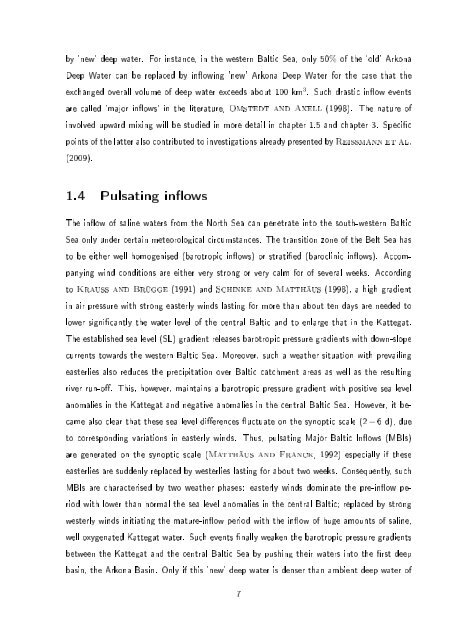Baltic Sea
Baltic Sea
Baltic Sea
You also want an ePaper? Increase the reach of your titles
YUMPU automatically turns print PDFs into web optimized ePapers that Google loves.
y 'new' deep water. For instance, in the western <strong>Baltic</strong> <strong>Sea</strong>, only 50% of the 'old' Arkona<br />
Deep Water can be replaced by inowing 'new' Arkona Deep Water for the case that the<br />
exchanged overall volume of deep water exceeds about 100 km 3 . Such drastic inow events<br />
are called 'major inows' in the literature, Omstedt and Axell (1998). The nature of<br />
involved upward mixing will be studied in more detail in chapter 1.5 and chapter 3. Specic<br />
points of the latter also contributed to investigations already presented by Reissmann et al.<br />
(2009).<br />
1.4 Pulsating inows<br />
The inow of saline waters from the North <strong>Sea</strong> can penetrate into the south-western <strong>Baltic</strong><br />
<strong>Sea</strong> only under certain meteorological circumstances. The transition zone of the Belt <strong>Sea</strong> has<br />
to be either well homogenised (barotropic inows) or stratied (baroclinic inows). Accompanying<br />
wind conditions are either very strong or very calm for of several weeks. According<br />
to Krauss and Brügge (1991) and Schinke and Matthäus (1998), a high gradient<br />
in air pressure with strong easterly winds lasting for more than about ten days are needed to<br />
lower signicantly the water level of the central <strong>Baltic</strong> and to enlarge that in the Kattegat.<br />
The established sea level (SL) gradient releases barotropic pressure gradients with down-slope<br />
currents towards the western <strong>Baltic</strong> <strong>Sea</strong>. Moreover, such a weather situation with prevailing<br />
easterlies also reduces the precipitation over <strong>Baltic</strong> catchment areas as well as the resulting<br />
river run-o. This, however, maintains a barotropic pressure gradient with positive sea level<br />
anomalies in the Kattegat and negative anomalies in the central <strong>Baltic</strong> <strong>Sea</strong>. However, it became<br />
also clear that these sea level dierences uctuate on the synoptic scale (2 − 6 d), due<br />
to corresponding variations in easterly winds. Thus, pulsating Major <strong>Baltic</strong> Inows (MBIs)<br />
are generated on the synoptic scale (Matthäus and Franck, 1992) especially if these<br />
easterlies are suddenly replaced by westerlies lasting for about two weeks. Consequently, such<br />
MBIs are characterised by two weather phases: easterly winds dominate the pre-inow period<br />
with lower than normal the sea level anomalies in the central <strong>Baltic</strong>; replaced by strong<br />
westerly winds initiating the mature-inow period with the inow of huge amounts of saline,<br />
well oxygenated Kattegat water. Such events nally weaken the barotropic pressure gradients<br />
between the Kattegat and the central <strong>Baltic</strong> <strong>Sea</strong> by pushing their waters into the rst deep<br />
basin, the Arkona Basin. Only if this 'new' deep water is denser than ambient deep water of<br />
7



